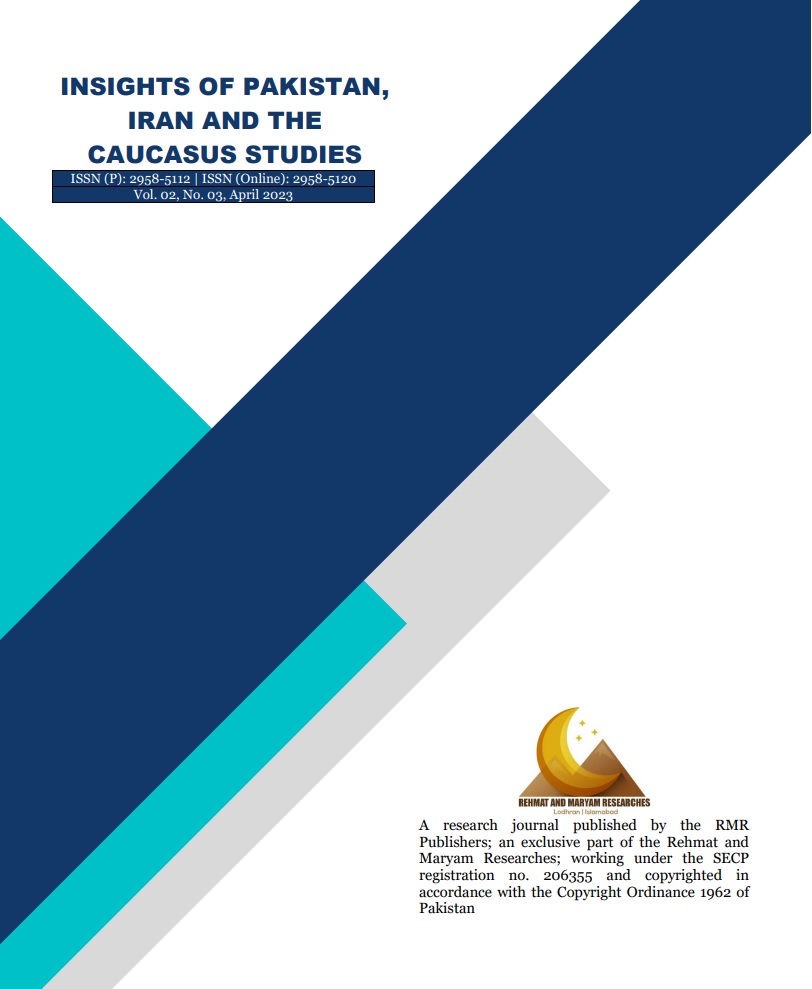Seeking Historical United Armenia; a Critical Analysis of Post-Soviet Armenian Ethno-National Movement
Keywords:
Hmidian, Nakhchivan, Dashnak, Javakhk, Parsarmenia, EghernAbstract
Historical Armenian highland belongs to several Armenian kingdoms during different centuries while some ethnographers present the modern history of the Armenian ethno-national movement since the Armenian Genocide under the Ottoman Empire in 1915. It elevated during the Stalin regime but got strength in 1988 when the pro-Armenian Nagorno-Karabakh Movement was initiated. Till then, Armenian ethno-national sentiments have prevailed in the entire regime. This study not only found the historical roots of emerging Armenian ethnic nationalism but also analyzes its post-Soviet strength. Similarly, the impacts of this movement on Armenian neighboring countries like Turkey, Azerbaijan and Georgia are also being evaluated in the study whereas; the political economy of this movement is discussed in the last.
References
Coene, F. (2009). The Caucasus - An Introduction. London and New York: Routledge.
Cornell, S. (2005). Small Nations and Great Powers: A Study of Ethnopolitical Conflict in the. London and New York: Routledge.
Darke, D. (2014). Eastern Turkey. London: Bradt Travel Guides.
Demirdjian, A. (2015). The Armenian Genocide Legacy. London and New York: Palgrave Macmillan.
Freedman, J. (2008). The Armenian Genocide. New York: The Rosen Publishing Group.
Geukjian, D. O. (2013). Ethnicity, Nationalism and Conflict in the South Caucasus: Nagorno-Karabakh the Legacy of Aoviet Nationalities Policy. Beirut: Ashgate Publishing, Ltd.
Herb, G. H. (2008). Nations and Nationalism: A Global Historical Overview. California: ABC-CLIO.
Hobbs, J. J. (2016). Fundamentals of World Regional Geography. New York: Cengage Learning.
Ishkanian, A. (2008). Democracy Building and Civil Society in Post-Soviet Armenia. London and New York: Routledge.
Kempton, D. R. (2002). Unity Or Separation: Center-periphery Relations in the Former Soviet Union. Westport: Greenwood Publishing Group.
Kingston, J. (2016). Nationalism in Asia: A History Since 1945. London: John Wiley & Sons.
Kocharli, T. (2004). Armenian Deception: Historical Information. Baku: Eldar.
Krikorian, O. (2016, April 12). New Data on Attitudes to Nagorno Karabakh Conflict Resolution (and Armenia-Turkey Relations). Retrieved from Conflict Voices: http://www.conflict-voices.net/blog/2012/04/new-data-on-attitudes-to-Nagorno-karabakh-conflict-resolution-and-armenia-turkey-relations/
Nuriyev, E. (2007). The South Caucasus at the Crossroads: Conflicts, Caspian Oil and Great Power Politics. California: LIT.
Panossian, R. (2013). The Armenians: From Kings and Priests to Merchants and Commissars. New York: Columbia University Press.
Payaslian, S. (2007). The history of Armenia: from the origins to the present. New York: Palgrave Macmillan.
Payaslian, S. (2011). The Political Economy of Human Rights in Armenia: Authoritarianism and Democracy in a Former Soviet Republic. London and New York: I.B.Tauris.
Recent from the Caucasus. (2016, March 26). Retrieved from The Jamestown Foundation: http://www.jamestown.org/regions/thecaucasus/single/?tx_ttnews
Report, I. B. (2015). Nagorno-Karabakh Republic Country Study Guide Strategic Information and Developments. New York: International Business Publications.
Salmassian, J. (2012). Javakhk: A World that Cares. California: Sally the Cat Publishing.
Schrodt, N. (2014). Modern Turkey and the Armenian Genocide: An Argument About the Meaning of the Past. Vienna: Springer.
Downloads
Published
Issue
Section
Categories
License
Copyright (c) 2023 Insights of Pakistan, Iran and the Caucasus Studies

This work is licensed under a Creative Commons Attribution-NonCommercial-NoDerivatives 4.0 International License.

